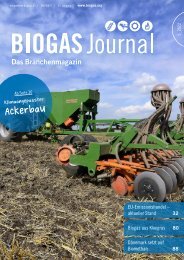Biogas Safety first!
You also want an ePaper? Increase the reach of your titles
YUMPU automatically turns print PDFs into web optimized ePapers that Google loves.
General requirements
Explosive limits
Gas storage tank
Gas purification
Hazardous area/Ex zone:
Hydrogen sulphide (H 2
S)
Installation room
Methane (CH 4
)
Normal cubic metre Nm 3
or m N
3
Nitrogen oxide
Safety distance
Solids feeding system
Substrate
Sulphur dioxide (SO 2
)
If the concentration of biogas in air exceeds a minimum value (lower explosive
limit, LEL), an explosion may occur. An explosion is no longer possible if the
concentration exceeds a maximum value (upper explosive limit, UEL).
Gas-tight tank or membrane gas holder in which biogas is held in temporary
storage.
Facilities for purifying biogas (e.g. desulphurisation).
Area in which a dangerous explosive atmosphere may occur due to local and
operational conditions.
Highly toxic, colourless gas that smells of rotten eggs; can be life-threatening
even in low concentrations.
Room where gas purification, gas pumping, gas analysis or gas utilisation
equipment is installed, including the associated instrumentation and control
equipment.
Colourless, odourless and non-toxic gas; its combustion products are carbon
dioxide and water. Methane is one of the most significant greenhouse gases
and is the principal constituent of biogas, sewage treatment gas, landfill gas
and natural gas.
One normal cubic metre is the amount corresponding to one cubic metre of
gas at a pressure of 1.01325 bar, humidity of 0 % (dry gas) and a temperature
of 0˚C.
The gases nitrogen monoxide (NO) and nitrogen dioxide (NO 2
) are referred
to collectively as NOx (nitrogen oxides). Nitrogen monoxide is a toxic but
colourless and odourless gas. Nitrogen dioxide is a reddish-brown, toxic gas
that has a pungent smell similar to chlorine. They are formed in all combustion
processes as a compound of atmospheric nitrogen and oxygen, but also as a
result of oxidation of nitrogenous compounds contained in fuel.
Area around gas storage tanks for the protection of the tank and its equipment.
Part of a biogas plant used for loading non-pumpable substrates or substrate
mixtures directly into the digester.
Raw material for anaerobic digestion or fermentation.
Colourless, pungent-smelling and toxic gas that irritates the mucous
membranes. In the atmosphere, sulphur dioxide is subjected to a range of
conversion processes which result in the formation of various substances
including sulphurous acid, sulphuric acid, sulphites and sulphates.
8


















